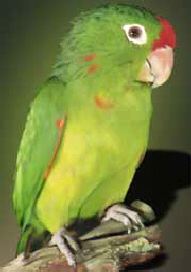Conure - Finsch's
Finschs Conure Scientific Name: Aratinga finschi
Sat, 21st June, 2025 - 12:08 am GMT
Sponsor Ads:

Alternative Name
Finschs Conure Scientific Name: Aratinga finschiBasic Info
Usually, Finsch's Conures grow to about 11 inches in captivity. They are predominantly green in color with red foreheads, forecrowns, and lores, although the red coloration never reaches the eyes. Finsch's Conures' wings are also red, as are the outer wing coverts. Usually, Finsch's Conures have drab yellow tails and their flight feathers are the same color. The lower breast and abdomen are both a bright yellowish green color. Finsch's Conures have white periopthalmic rings and their irises are a dark red-orange color. While their feet are usually gray, Finsch's Conures may have flesh colored feet to match their horn colored bills! Some Finsch's Conures have isolated bright red feathers scattered over their bodies. Adult coloration is usually acquired by two years of age, and as Finsch's Conures age, they tend to become even more brilliant and gorgeous!
Health
In captivity, Finsch's Conures need a variety of fresh fruits, vegetables, and legumes to ensure proper nutrition and to avoid boredom! Their seed mix should consist mainly of millet, sunflower, paddy rice, canary grass, oats, wheat and safflower. They love carrots, apples, half-ripe corn, green food, rowanberries, and rose hips! Be sure to give your Finsch's Conure regular mineral supplements to keep him healthy. Fresh water should be available to them at all times, and these Conures love to bathe. Provide them with a nesting box so they may feel safe and so they can sleep in peace! Finsch's Conures may be kept with other birds outside their mating season, and are not big chewers. They will thrive in an outdoor nine-foot by three foot by six foot aviary, which is sheltered from the elements. Breeding In the wild, Finsch's Conures begin breeding when the wet season starts. In captivity, they usually breed around April or July. Generally, they nest in broken palm tops or hollow trees, and in captivity, they must be provided with a nesting box. Isolate the Finsch's Conure pair you would like to breed and offer them a ten inch by ten inch by 20 inch nesting box with a two and a half inch entrance hole. They are not too difficult to breed but sometimes will fail. A Finsch's Conure typically produces a clutch of three or four eggs, which incubate about 24 days. The fledgling period generally carries through until the young are about 50 days old. When hand rearing Finsch's Conures, offer biscuit and dry, crisp bread. They will begin to acquire their red headed adult coloration at one year of age. Immature Finsch's Conures have darker irises than adults.Habitat
Finsch's Conures are quite common and are native to open forest areas as well as tropical and subtropical forest areas below 1, 600 meters. They also enjoy wooded agricultural areas.Behavior
A small, playful and affectionate pet, Finsch's Conure is quite common in its natural habitat and in captivity! In the wild, Finsch's Conures fly in flocks of six to 100, but maintain pairs within the group. Generally, they are migratory and use the dawn and dusk hours to fly to and from the trees where they roost. Finsch's Conures are quite noisy until night falls, when they quiet down, which they also do during heavy rains. Up to 500 birds may use the same tree to roost in, and they quarrel over it continuously. Finsch's Conures have raucous calls and in captivity are a bit noisy. Fresh water should be available to them at all times, and these Conures love to bathe. Provide them with a nesting box so they may feel safe and so they can sleep in peace! Finsch's Conures are confiding and affectionate once they get to know their keepers, and are easily trained to do tricks! Captive-bred birds make healthier, more affectionate pets than wild-caught birds, although both are very hardy once they become acclimatized! Be sure your Finsch's Conures are kept warm and frost-free in winter. Remember they come from the tropics!Origin
PanamaHistory
Finsch's Conures are quite common and are native to open forest areas as well as tropical and subtropical forest areas below 1, 600 meters. They also enjoy wooded agricultural areas. First recorded by Salvin in 1871, Finsch's Conures are found in Nicaragua, western Panama and eastern Costa Rica. They were imported into the United States up until the 1980's, but now these affectionate, charming little birds are becoming a bit difficult to find in captivity. They are flourishing in the wild.Common Foods
In the wild, they eat nuts and seeds, fruits and berries, and whatever vegetation or crop leavings they can find. In captivity, Finsch's Conures need a variety of fresh fruits, vegetables, and legumes to ensure proper nutrition and to avoid boredom!Sponsor Ads:
"No, this trick won't work...How on earth are you ever going to explain in terms of chemistry and physics so important a biological phenomenon as first love?" -- Albert Einstein
Conure - Finsch's
Coded by: BGID® | ALL RIGHTS RESERVED Copyright © 2000-2025
Disclaimer | Privacy | Report Errors / Contact | Credits

 Preparing For China. China is growing their military. China Military Technology - can it keep up with the US?
Preparing For China. China is growing their military. China Military Technology - can it keep up with the US?  versus
versus 

 versus
versus 
 This Thread is about the North Korean Military itself - the kind of army, navy, and air force they have.
This Thread is about the North Korean Military itself - the kind of army, navy, and air force they have. 
 versus
versus 
 versus
versus  versus
versus